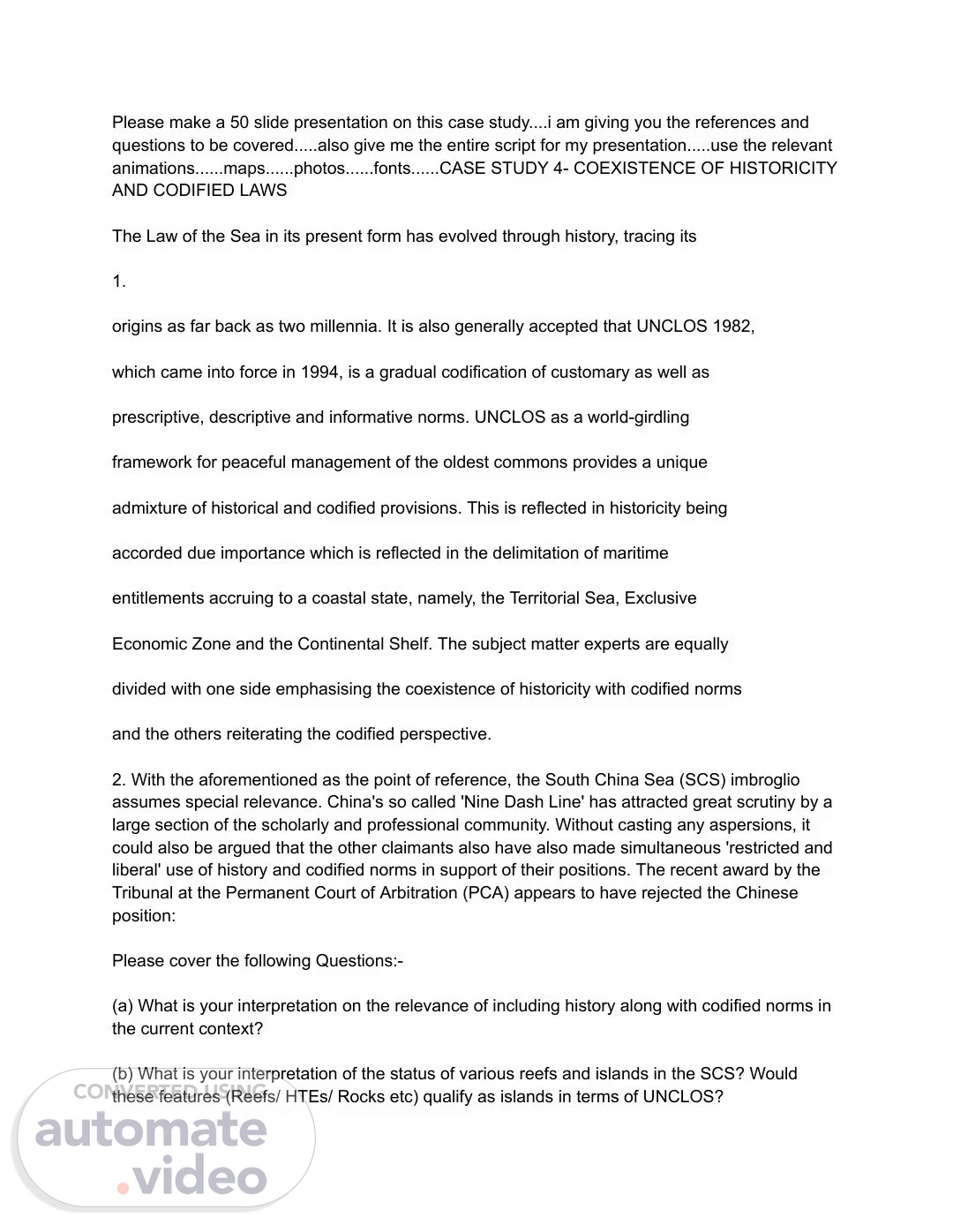Scene 1 (0s)
Please make a 50 slide presentation on this case study....i am giving you the references and questions to be covered.....also give me the entire script for my presentation.....use the relevant animations......maps......photos......fonts......CASE STUDY 4- COEXISTENCE OF HISTORICITY AND CODIFIED LAWS The Law of the Sea in its present form has evolved through history, tracing its 1. origins as far back as two millennia. It is also generally accepted that UNCLOS 1982, which came into force in 1994, is a gradual codification of customary as well as prescriptive, descriptive and informative norms. UNCLOS as a world-girdling framework for peaceful management of the oldest commons provides a unique admixture of historical and codified provisions. This is reflected in historicity being accorded due importance which is reflected in the delimitation of maritime entitlements accruing to a coastal state, namely, the Territorial Sea, Exclusive Economic Zone and the Continental Shelf. The subject matter experts are equally divided with one side emphasising the coexistence of historicity with codified norms and the others reiterating the codified perspective. 2. With the aforementioned as the point of reference, the South China Sea (SCS) imbroglio assumes special relevance. China's so called 'Nine Dash Line' has attracted great scrutiny by a large section of the scholarly and professional community. Without casting any aspersions, it could also be argued that the other claimants also have also made simultaneous 'restricted and liberal' use of history and codified norms in support of their positions. The recent award by the Tribunal at the Permanent Court of Arbitration (PCA) appears to have rejected the Chinese position: Please cover the following Questions:- (a) What is your interpretation on the relevance of including history along with codified norms in the current context? (b) What is your interpretation of the status of various reefs and islands in the SCS? Would these features (Reefs/ HTEs/ Rocks etc) qualify as islands in terms of UNCLOS?.
Scene 2 (1m 5s)
[Audio] What is your interpretation on the relevance of including history along with codified norms in the current context? History and codified norms are both important in understanding the legal system. History provides context and perspective while codified norms provide a clear framework for legal behavior. In the South China Sea where there are complex historical and political factors at play it is important to consider both aspects in order to fully understand the legal situation. What is your interpretation of the status of various reefs and islands in the South China Sea? Would these features qualify as islands in terms of UNCLOS? The status of reefs and islands in the South China Sea is a matter of debate. While some argue that these features should be considered islands under UNCLOS others argue that they do not meet the criteria. The issue of the status of these features has been raised many times and it is important to consider the interpretive logic used in determining their status. Do you feel that UNCLOS requires a major review or a minor revision for greater relevance and ease of interpretation? The issues regarding the lack of clarity on the status and the interpretative logic used in relation to maritime insular features like the regime of islands low tide elevation rocks and reefs have been raised many times. While some may argue that a major review of UNCLOS is necessary others may suggest a minor revision to make the law more clear and easier to interpret..
